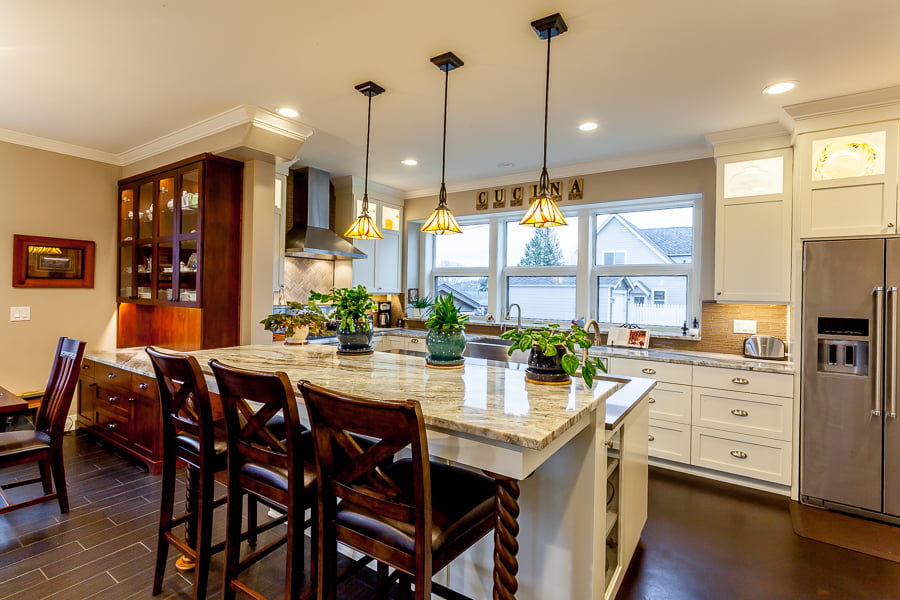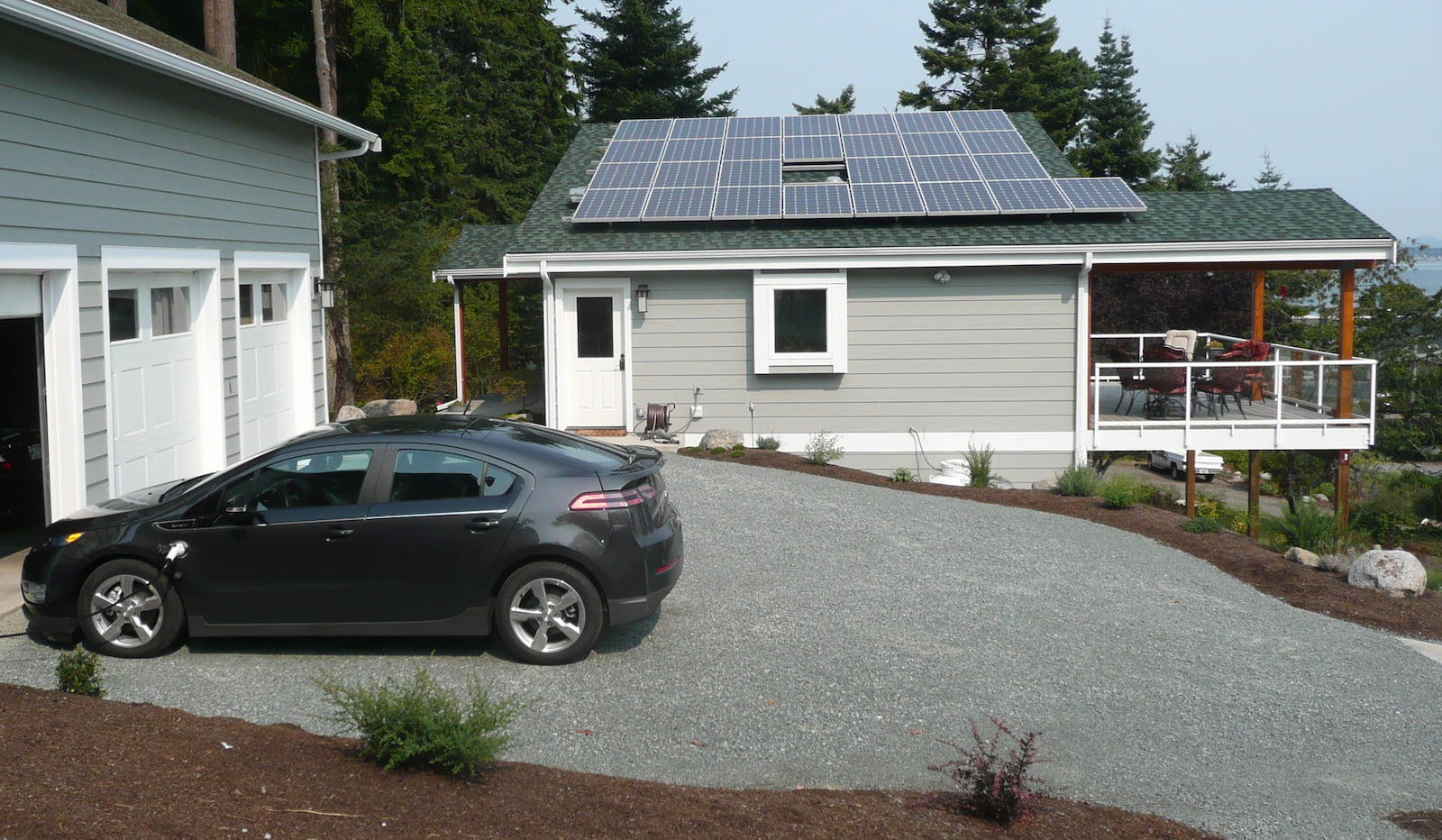In this post, Zero Energy Project founder Joe Emerson interviews zero energy home pioneer Ted Clifton. After decades as a high-performance home designer and builder, Ted shifted his focus to taking energy efficiency to its logical conclusion – positive energy homes that can also power electric vehicles.
JE: How did you get interested in zero energy homes?
TC: I have been interested in building a more efficient home since I was a teenager studying drafting in high school. Around 2006, I attended the national Green Building Conference in St. Louis, MO, where William McDonough was the keynote speaker. “Less bad is not good; it is still bad” was one of his comments that inspired me to get better at what I was already doing. I also knew already that most people burn more energy in their cars than they do in their homes, so it became an imperative to be able to also power the car using the energy generated by the house. A HERS rating of “0” is only halfway there!
JE: How did Zero Energy Plans get started?
TC: Inspired by the Green Building Conference, we designed and built our first zero energy home in 2007-2008. Since then we have built a couple of dozen, through our construction company, Clifton View Homes. I started Zero Energy Plans to make the proven zero-energy home designs we had already drawn available to others to advance the concept of how homes should be built. The overwhelming majority of people inquiring about our plans, however, have unique needs, wants, and locations, so we have morphed into a full-service design company, specializing only in zero energy and positive energy home designs. In the last two years, we have also become a supplier of essential and hard-to-source products for our Zero Energy Home Plan customers, such as highly efficient Vinyltek windows and doors and SIPS.
JE: How many zero energy homes have you designed?
TC: I lost track of how many we have designed because, at present, I am finishing up about a plan every week, and some weeks it is two or three plans. This pace has been going on for a couple of years, at least. When I glanced recently at the totals the Net Zero-Energy Home Coalition has put together, I think about 10% of them must be my designs.

JE: I understand your homes have won some awards.
TC: Yes, each year the US Department of Energy holds the Housing Innovations Awards, for any homes meeting the DOE Zero Energy Ready program standards. We have earned at least one such award each year since their inception, and going back to 2008, when our first ZEH earned a gold level Energy Value Housing Award (EVHA), which was the predecessor of the current award program. At least three times, our plans have earned three of these awards in a single year and we are the only single company or designer to have done that ever. Many of our homes are listed in the DOE Tour of Zero. We have earned two or more each year for the last six or seven award cycles, though we only earned one this year, with one “honorable mention.” The competition is getting tough!
This year’s winner (see photos) has a HERS rating around -18, and is powering a Prius plug-in hybrid, in addition to powering itself. The granite counter tops in the south-facing kitchen bump-out window (shown from each side in these two pictures) is part of the thermal-mass strategy of this house. The home is built on a 4″ concrete slab, with 4″ of rigid foam insulation below, and a perimeter insulation of R-10 down to the tops of the footings. The 6-1/2″ Neopor SIPs walls are about R-28 for the assembly, and the 10-1/4″ Neopor roof is about R-46 for the assembly, with no thermal bridging. We achieved a blower-door test result of .82 ACH 50. This home also earned the top Excellence in Building Award from the SIPS Manufacturers Association, SIPA.
JE: What have you learned making zero energy homes cost effective?
TC: One of the things I have learned about building cost-effective homes is that there are always ways to spend more building a home, like finer finishes, but there are only two things you can put in a house that will pay for themselves over time, and those are energy efficiency, and renewable energy. And if you don’t get enough of the first one, you are just wasting your time and money on the other.
In other words KEEP IT SIMPLE! If you can get the same result using less money and material, that is more “green.” There is no magic bullet that you can add to a house to make it better. Begin with a simple design. The closer to a cube the whole structure is, the more options you have in all the other areas. Then, figure out what you can subtract, without affecting quality of life.
Another way to keep costs down is to not let your subcontractors tell you what they cannot do. I spent about the first 20 years of my adult life bouncing around from one trade to another, learning along the way how each phase is done. Teach a man how to fish, and you will never see him again. Teach a man how to make money doing your work for less, and he will be back time and again.
We get a HERS rating on every house, and throw in a Built Green® certification as well. If you don’t measure it, you can’t manage it. Part of the measuring process involves measuring actual performance against the HERS rated performance. Most of our homes have significantly out-performed their HERS ratings, because we have employed techniques that REM/Rate had not even contemplated yet and, initially, did not know how to measure such as under-slab and perimeter insulation, and because we used new technologies such as earth tubes that can perform like an HRV, an air conditioner, and a dehumidifier. By only adding one or two new techniques to each house, we are able to identify which ones work better, and by how much. Build, measure, repeat.
My customers bring me the cool new technology, and they ask to have it in their homes. I evaluate their suggestions as scientifically as I can, and make recommendations to either use, or not use, a given product. Sometimes it is not that simple. It might be a great idea, but just not enough time behind it to get it right or it may not be cost-effective.
JE: Do you have any advice for prospective zero energy home buyers?
TC: Find professionals who know what they are doing, and get behind their work. Enjoy the process, because it can be just like Christmas, opening up possibilities one by one as you move forward with your project. Our customers love their homes and only one of our zero-energy homes has ever been re-sold. It sold for almost $100K more than the real estate broker wanted to list it for. We displayed some of the national awards, and other energy information about the house on the dining table for people to see while walking through the house, and the solar panels on the roof, and car-charging station in the carport were fairly obvious, so the customers could make up their own minds. We are currently building a larger zero-energy home right across the street from that one, on a double lot, for that same couple. They can pay cash for this one, because they did so well on the last one.
JE: What will it take for zero energy homes to become the new normal?
TC: I could write a book on how to get zero energy homes mainstream. The short answer is that we need to break apart the 110 year-old monopolies we gave the power companies, and recognize that anyone who wants to can be an effective producer of power. The existing power companies need to become grid managers, for which they would be justly compensated. If I choose to buy “Green Power,” as produced by my neighbor, at whatever price the traffic will bear, then good for me, and good for him. We need to solve the “duck curve” problem by incentivizing owners of PV to also incorporate enough battery bank into their system to at least take care of their own portion of the duck curve. We can do this by reducing the existing solar power tax credit to just 10%, UNLESS you also add the right-sized battery component, in which case you would get the full 30%. This would virtually pay for the batteries, as it helped solve the duck curve for all.
The challenge, though, is bigger than solving the duck curve. We have an 18-unit duplex development currently under construction in Sonora, CA. With PV only on the garages, we can power all the homes, and 30 cars (2 per 2-bedroom, 1 per 1-bedroom unit) for about 10,000 miles per year per car. If we also powered up the roofs of the all-south-facing shed roofed homes, we could power up an additional 54 existing homes in the neighborhood. Now here is the kicker: If all 1,100,000 homes built in America each year for the next 50 years were built that way, we would finally get off fossil fuels. That would require about 55,000 such developments to be built each year. In spite of our current oversupply, we only have about an 84-year supply of natural gas and maybe 40 years of oil in US control at current consumption rates, and only about 55 years of oil and natural gas at current consumption rates for the whole rest of the world. What then?
JE: What do you like best about zero energy homes?
TC: The best thing about zero energy homes is standing there for hours and watching the meter spin backwards. Simple things for simple minds? Maybe so. But seriously, we have a HUGE energy problem to solve, and the sooner we get to it, the longer we will have to fully solve it. I like being a part of the solution.

